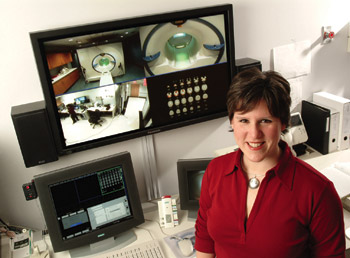Do Gifted People Think Differently?
May 3, 2010
Educational psychologist and cognitive neuroscientist Layne Kalbfleisch plans to find out. In her research, she is trying see how the brains of intellectually gifted children, especially those who have attention deficit hyperactivity disorder and high-functioning autism, operate differently than the typical brain.
To do this, she is using neuroimaging technology known as fMRI, functional magnetic resonance imaging. A safe, noninvasive technology, fMRI measures the rapid changes that occur in certain parts of the brain. When a subject is working to solve some intellectual task in the fMRI, researchers can see parts of the brain begin to glow and fade like lights switched on and off in different rooms of a house. Although fMRI labs are normally affiliated with medical centers, Mason is one of only three nonmedical schools in the country with its own scanner.

Layne Kalbfleisch oversees Krasnow Investigations of Developmental Learning and Behavior, or KIDLAB as it is more commonly known. KIDLAB's goal is to contribute new insight into how the brain develops, learns, creates, and solves problems throughout the lifespan.
To help her examine children's brain activity, Kalbfleisch has devised a series of nonverbal behavioral exercises that look like puzzles. Some are based on the Naglieri Nonverbal Ability Test, developed by Mason psychology professor Jack A. Naglieri. Because these tests are based on patterns, they are not language-based, which allows her to test young children as well as subjects who speak different languages, a boon for her planned collaboration with Dutch researchers to study environmental influences on brain development and function.
"We'll be able to see the trade-off in brain real estate—certain areas people will and won't use to solve problems," says Kalbfleisch, the Pomata Term Professor of Cognitive Neuroscience.
She indicates the long-term results of her research have implications for educational intervention and the construction of educational environments, in both school classrooms and adult education venues, as well as health care, possibly allowing doctors to identify brain disorders earlier and pharmaceutical companies to develop drugs to "block" disease.
